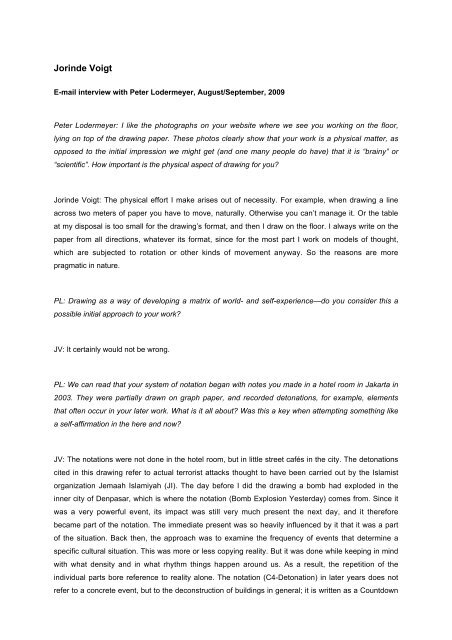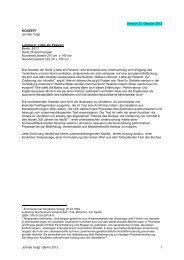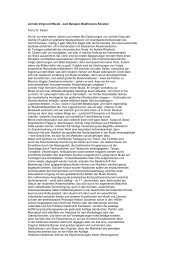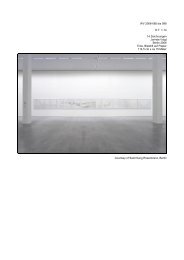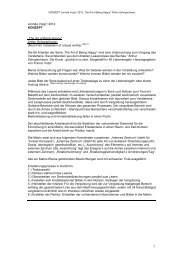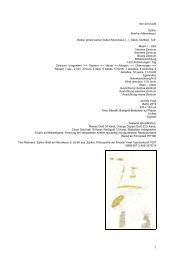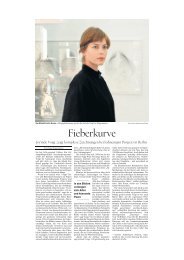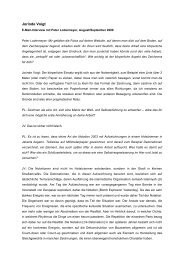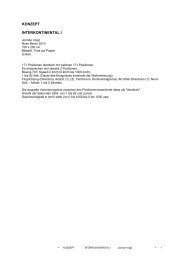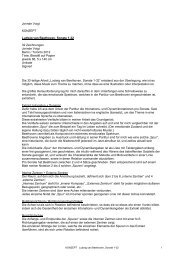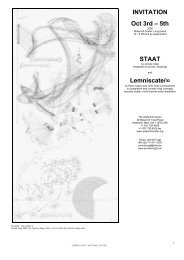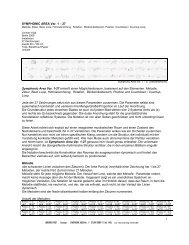Jorinde Voigt
Jorinde Voigt
Jorinde Voigt
You also want an ePaper? Increase the reach of your titles
YUMPU automatically turns print PDFs into web optimized ePapers that Google loves.
<strong>Jorinde</strong> <strong>Voigt</strong><br />
E-mail interview with Peter Lodermeyer, August/September, 2009<br />
Peter Lodermeyer: I like the photographs on your website where we see you working on the floor,<br />
lying on top of the drawing paper. These photos clearly show that your work is a physical matter, as<br />
opposed to the initial impression we might get (and one many people do have) that it is “brainy” or<br />
“scientific”. How important is the physical aspect of drawing for you?<br />
<strong>Jorinde</strong> <strong>Voigt</strong>: The physical effort I make arises out of necessity. For example, when drawing a line<br />
across two meters of paper you have to move, naturally. Otherwise you can’t manage it. Or the table<br />
at my disposal is too small for the drawing’s format, and then I draw on the floor. I always write on the<br />
paper from all directions, whatever its format, since for the most part I work on models of thought,<br />
which are subjected to rotation or other kinds of movement anyway. So the reasons are more<br />
pragmatic in nature.<br />
PL: Drawing as a way of developing a matrix of world- and self-experience—do you consider this a<br />
possible initial approach to your work?<br />
JV: It certainly would not be wrong.<br />
PL: We can read that your system of notation began with notes you made in a hotel room in Jakarta in<br />
2003. They were partially drawn on graph paper, and recorded detonations, for example, elements<br />
that often occur in your later work. What is it all about? Was this a key when attempting something like<br />
a self-affirmation in the here and now?<br />
JV: The notations were not done in the hotel room, but in little street cafés in the city. The detonations<br />
cited in this drawing refer to actual terrorist attacks thought to have been carried out by the Islamist<br />
organization Jemaah Islamiyah (JI). The day before I did the drawing a bomb had exploded in the<br />
inner city of Denpasar, which is where the notation (Bomb Explosion Yesterday) comes from. Since it<br />
was a very powerful event, its impact was still very much present the next day, and it therefore<br />
became part of the notation. The immediate present was so heavily influenced by it that it was a part<br />
of the situation. Back then, the approach was to examine the frequency of events that determine a<br />
specific cultural situation. This was more or less copying reality. But it was done while keeping in mind<br />
with what density and in what rhythm things happen around us. As a result, the repetition of the<br />
individual parts bore reference to reality alone. The notation (C4-Detonation) in later years does not<br />
refer to a concrete event, but to the deconstruction of buildings in general; it is written as a Countdown
or Count-up, generally serving as an element with which to create balance in some drawings that are<br />
largely constructive in character.<br />
PL: I think that your works, which are highly repetitive in parts, display the character of “exercise or<br />
practice”. You yourself once compared them to competitive sports. How does the feedback between<br />
you and your work function? What is the existential yield from such “work on the self”?<br />
JV: The quote about competitive sports is incorrect. It was something the author at the “Tagesspiegel”<br />
made up. i The repetitive parts of the working process stay within limits. When a structure needs to be<br />
repeated often, because otherwise its character would not be visible, that is just what I do. At most,<br />
this heightens your concentration. But since I deal a lot with algorithms that produce an endless<br />
structure, of course I have to do a kind of follow-up work. But this is not as boring as you would think,<br />
since the algorithm only prescribes what is connected to what, but not how this is to be done. That<br />
means half of the process is spontaneous invention.<br />
PL: What significance do the algorithms have? Are they self-applied rules or are they stimuli that come<br />
from the “outside”, i.e. from the cultural material, the fragments of reality, which you integrate into your<br />
work?<br />
JV: The algorithms are self-applied rules. I develop an algorithm from my observation of a<br />
phenomenon, its structure, its “character”. After all, the algorithm forms the subsequent framework for<br />
the text and the directions in which it progresses, etc. Various aspects are inherent to it, such as<br />
whether or not something develops from within itself (whether it is static or dynamic), whether it<br />
becomes smaller or larger, increases or decreases, whether it triggers a second or a third thing, etc.,<br />
whether it integrates effects from the outside or if it is autonomous, and so on.<br />
PL: Drawings by Hanne Darboven—whose art we both admire—were often criticized and accused of<br />
being mere “busywork”. In an interview she once expressly professed to the “secondary virtues” of<br />
diligence, order and discipline, but she added that her works “were full of responsibility”. Can you<br />
relate to this concept of responsibility with respect to your work?<br />
JV: This touches on its irreversible nature. When I draw, I cannot correct it, at least not the long<br />
stretches. This means you are directly concerned with irreversible processes. Because of this, you are<br />
acutely aware of your responsibility at every moment. You realize that what you are in the process of<br />
writing will always be a part of your future and final work. I believe it is important that the thought<br />
model can be retraced logically, both for me and for others: this is why I also feel a responsibility to do<br />
not do just anything, but to use my time and the time of others responsibly, coming to an arrangement
which makes sense in itself and allows us to conquer new realms of thought. If it is to result in a<br />
cohesive field, it can always only build upon something that already exists, and then progress in small<br />
steps. It is precisely when portraying spaces of possibility that juxtapose diverse variations of the Now<br />
as a departure point, i.e., depicting a space where the Now can reveal its range of possibilities, that it<br />
takes a while to get all of this written down. But it is also the only possibility to get rid of the linearity of<br />
your own time. And this happens, at the latest, when viewing the result. Nevertheless, you have to<br />
pass through each individual moment. With such projects, your life-time is identical to the time it takes<br />
to record it. Most certainly.<br />
PL: Can you explain in more detail what these spaces of possibility are all about, especially what you<br />
mean when you talk about the “only possibility to get rid of the linearity of your own time”? Are you<br />
aiming to enter into a different relationship with time when you draw?<br />
JV: It has never been an intention, but it is often a discovery while dealing with models of time. You<br />
automatically reach a place that touches more dimensions than those we are accustomed to dealing<br />
with. But this develops of its own accord. Perhaps an inherent logic is revealed here.<br />
PL: In an article dating from 2008, Andrew Cannon cited a parallel between your work and the<br />
dreamtime of the Aborigines and, using a term coined by anthropologist W.H. Stanner, called it<br />
“everywhen”. Do you agree with this analogy?<br />
JV: “Everywhen” is certainly an interesting concept of time. But I am far from committing myself to any<br />
definition of time as adequate. And I am unable to relate to the “dream” part of it. After all, my working<br />
method is only possible when absolutely wide-awake. Thought is a more than three-dimensional<br />
moment of constant retrospection and discovery. But there is entropy and nothing exists outside of<br />
this. All matter is subjected to successive change (and in my experience, the immaterial does not exist<br />
without being linked to something material). This means that things have an inherent direction. It is a<br />
kind of movement, of development from one state to the next, and the loss or gain of characteristics in<br />
connection with this. In this sense, there is something akin to a clear before and after, or a chain of<br />
events, which may not be randomly interchanged.<br />
PL: In an earlier interview you once said: “the space that I imagine when drawing a score is very<br />
similar to the one I imagine when listening to or making music.” Could you elaborate on this space of<br />
the imagination and its musical pendant?<br />
JV: Well, it is the view to the inside …<br />
PL: Does this view have something to do with self-exploration, with positioning yourself in an
existential context?<br />
JV: It has to do with exploring what is “conceivable” for you personally. It is more a contemplation of<br />
your own possibilities of thought, letting your imagination take flight, to put it more simply.<br />
PL: What is the relationship between space/time structures and music in your work? What kind of<br />
musical experiences are important to you here?<br />
JV: The most important thing about musical experience is how the overall intellectual, as well as<br />
emotional spectrum may be communicated by connecting it to a rhythmic or inherently proportionate<br />
structure, and what tremendous fun and joy this can create. The aspect of collective perception is also<br />
highly interesting. A pop-song, for example, can be an element for storing collective and private<br />
emotions, as well as the (historical) situation.<br />
PL: In the same conversation you said that your concern when drawing/writing was with “the<br />
‘existence’ during the drawing process”. This existence interests me; this thought process which<br />
creates its own visual material in the process of writing/drawing. What is the essential motivation<br />
here?<br />
JV: It is almost a synchronization of thought and action. The drawing itself, ultimately, delineates a<br />
thought process. The concept for a drawing defines the axes along which something is considered.<br />
The writing process itself has certain degrees of freedom, such as in what direction, with what<br />
momentum, with what intensity I write it. What it looks like then depends on the moment, what kind of<br />
mood you are in, how you spontaneously decide to do it. Afterwards it is always part of the result.<br />
There is nothing neutral about it, because each moment, as long as you are alive, is subject to these<br />
shifts in energy: it is only real, therefore, when you let it be part of the consideration. Anything else<br />
would be a lie. On the one hand, each spontaneous curve is specific, individual, but it also stands for<br />
every possible spontaneous curve that you could have drawn. That is the most important aspect about<br />
it.<br />
PL: Back to the subject of music: the composer Helmut Lachenmann once referred to music and<br />
listening to music as an “existential experience”. As he sees it, listening to demanding music means<br />
“to change, to discover yourself anew in your changeability.” Would you care to comment on this<br />
description with respect to your own works?<br />
JV: That’s the underlying reason for my work: to explore what is imaginable and the way that
perception functions. The discoveries you make in this process change you a lot, of course. At any<br />
rate, they change me.<br />
PL: I would like to hear more about that. That is the point where the execution has an effect on the<br />
executor. I am interested in those feedback effects.<br />
JV: The effect is that you constantly challenge yourself to rethink everything and try it out again.<br />
Actually, it is like working on one idea after another; and when you are trying them out, of course, new<br />
ideas arise that you want to pursue.<br />
PL: In your works there are frequently “dual” or rather relational, structures. This seems to be essential<br />
to me, and it makes your work different from fairly “monadic” conceptual statements such as those<br />
made by Roman Opalka or On Kawara. Can you address the importance of this duality?<br />
JV: The fundamental, relational concepts for thought models which I use to develop systems are<br />
borrowed from the structure of my environment. I do not exist in isolation; I move within a social<br />
environment, share in ideas developed by others, and deal with pre-existing systems that I live in,<br />
reject, repeat, create, or consolidate. A singular, isolated system does not exist in a non-pathologically<br />
conceived environment. It only exists in a religious context or in totalitarian systems.<br />
PL: One element strikingly related to time in your work is the repetitive, rhythmic aspect with recourse<br />
to frequencies and repetition loops. What is the significance of this for the production and perception<br />
of your works?<br />
JV: This is the most basic structure of all. Everything that is alive, and my attention is directed towards<br />
that—I am also alive myself—is subject to rhythms. That is the only reason it remains alive.<br />
PL: Tell us more about this “vitalism” in your work. Of course, this is what brings us to the key theme<br />
of the link between art and life…<br />
JV: The most fundamental, age-old question each day is what this actually is - what happens to us<br />
every day, what we see, and what surrounds us. We try to understand the underlying structures<br />
behind all this. And that requires experimental setups. Extracting aspects, letting situations run like<br />
“machines”; playing around with all this in order to discover the possibilities. I always assume that any<br />
existing concrete situation is only a variation.
PL: You once said that elements of your work taken from the real world were put through “highly<br />
absurd moments” by subjecting them to formal declensions, permutations, etc. Especially in French<br />
existentialism, absurdity is a designation of existential world experience. What value does the absurd<br />
element have in your work?<br />
JV: It functions something like liberation from the structures within which things are normally<br />
portrayed. In my work a situation always leads from the known relationship of the parameters to a shift<br />
or vice versa. That is to say, the absurdity occurs logically in small steps.<br />
PL: Is absurdity only another word for freedom, then?<br />
JV: No—it’s playing with things.<br />
PL: Your drawings have mostly been done in series and feature systemic changes of conditions. Do<br />
the scientific trends of the last decades such as system theory, complexity research, self-organization,<br />
or bionics provide an intellectual background to your work?<br />
JV: Existing theories are not directly reflected in my work, except perhaps when I use the Fibonacci<br />
sequence and its translation into duration, temporal and spatial distance as well as quantity during the<br />
notation of a “2-kissing-each-other” action. But the themes you mentioned in the question all interest<br />
me greatly.<br />
PL: The elements of real experience repeatedly used in your drawings are quantifiable or measurable<br />
conditions or relationships such as temperatures, wind directions, periods of time, etc. With the<br />
exception of “2-kissing-each-other”, none of the elements appear to indicate emotional states directly.<br />
Why is there this preponderance of “objectively” describable, “neutral” components?<br />
JV: As I always use designations that signify the full range of connotations (pop-song, eagle,<br />
electricity, 2-kissing-each-other, temperature progression, black BMWs, angle of view, C4-detonation,<br />
etc.), I do not perceive this as being so neutral at all. I also looked at this question of emotionality, of<br />
how an element could be developed from it, but I believe it is already formulated in the making of the<br />
work, since it is impossible to be unemotional.<br />
i Jens Hinrichsen, “Fieberkurve”, in Tagesspiegel, June 29, 2007: “The draughstwoman needs to keep track of things, however.<br />
She may not mess up any curve, or otherwise the page is ruined. <strong>Jorinde</strong> <strong>Voigt</strong> points to an especially delicate weave of threads
in the entry area of the gallery: ‘I drew on this work eleven hours a day for six weeks. This is like competitive sports.’”<br />
(http://www.tagesspiegel.de/kultur/<strong>Jorinde</strong>-<strong>Voigt</strong>-Ausstellung;art772,2330942)


